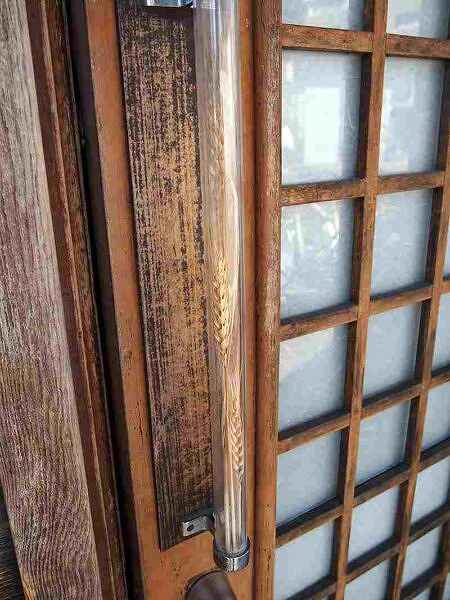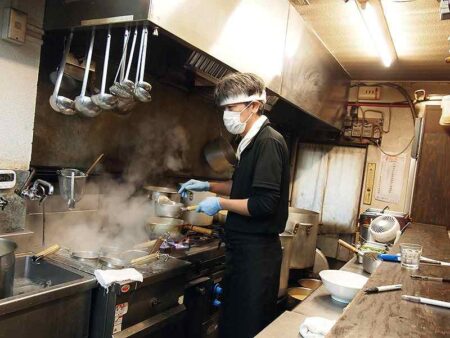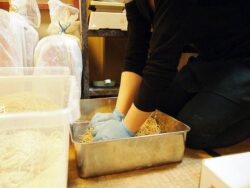
Komugi’s soy sauce ramen dish with a seasoned egg (¥880)
16:42 JST, December 24, 2020
Koshigaya in Saitama Prefecture is home to the largest mall in Japan, Aeon Lake Town. At a whopping 224,000 square meters, the mall in itself is impressive enough, but the city is also home to a popular ramen shop called Komugi.
Komugi is just a 10-minute walk from Koshigaya Station, and with a name that means wheat in Japanese, its not so surprising that you’ll find an entrance door with its handle decorated with wheat ears and a display window with a large noodle maker – or is it just me?

The exterior of Komugi

Wheat ears are put inside the door handle.

A noodle maker displayed at the shop
When you enter the shop, you’ll find a ticket vending machine to the side where you can place your order — I got their special shoyu (soy sauce) ramen with seasoned egg — and an L-shaped counter with eight seats ahead. The kitchen is situated behind the counter so you can easily see the ramen chefs at work.

Ticket vending machine

Teruyuki Hasegawa, the shop manager, checks the time of boiling noodles.

Eight customers can sit at the L-shaped counter.
I sat at the counter and found a list that contains an explanation of the ingredients used in their ramen. In the midst of my perusal, I saw that durum semolina flour is an ingredient being used. This immediately caught my eye as my husband had often mentioned it when he was making homemade pasta. I instantly began looking forward to eating ramen noodles made from pasta flour.
My gaze drifted to the two chefs working diligently in front of me and I became fascinated with their perfect coordination: when one man puts noodles in a bowl, the other, without pausing, quickly breaks up the noodles with cooking chopsticks, then the dish is efficiently topped off with the necessary condiments. And before I knew it, my ramen was ready.
As it was cold outside, the steaming soup stock that wafted up from the bowl seemed to have soothed my insides. I scooped up a spoonful and the thick broth reminded me of tonkotsu soup.

After taking a sip, the soup’s flavor, which is reminiscent of my childhood, spread throughout my mouth, then left a slightly gentle sweetness in its wake. I wondered about the sweetness for a bit but soon the yuzu got my attention. I liked the mixture of flavors — the subtle scent of citron added a certain elegance to the ramen.
The noodles are thin and slightly brownish — a color that’s probably due to the use of roasted wheat embryo powder. They were also chewy and definitely reminded me of pasta.

Soy sauce soup scooped out with a spoon

Thin noodles

Hosaki menma curled in a spoon
The soup mixed well with the thin noodles, and every time I took a bite, the refreshing aroma of yuzu tickled my nostrils.
It was my first time to see “Hosaki menma,” which is the tip of menma (seasoned bamboo shoots), used as a ramen topping. Often, it’s the actual bamboo shoot that’s used as a condiment. When I picked it up, I could see that it had a similar shape to bamboo shoots that are often found in Japanese-style stews. It was soft enough for me to easily bite with my front teeth, and just as sweet as the broth. It was delicious. Menma always plays a supporting role in a dish for me, but I feel I’d come to this shop specifically for their Hosaki menma.
As for the chashu roasted pork, the savoriness and richness of the fatty meat harmonized exquisitely in my mouth. It was by far my favorite chashu.
After I finished eating, I felt quite nice and warm.
Sweetness and umami condensed

“I want to continue making ramen that will be loved forever,” said Komugi founder Shigeru Narita. He also runs a yakiniku (grilled meat) chain restaurant.
He has loved food since he was a child, especially noodles such as soba and udon. “Soba has been loved for a long time in Japan and ramen is a relatively recent love. I wanted to fill the dish with merits from the two,” he said.
As soon as he decided to open a ramen shop, he began his study of the craft at a ramen school.
His aim was to create a soy sauce soup that’s based on soba noodle soup, which he thinks is delicious. To help accomplish this, he adds thoroughly boiled mirin to dashi broth and soy sauce. At the shop, mirin is boiled down until it’s reduced to two-thirds of its original volume. This procedure condenses the sweetness and umami flavor, which sugar can’t produce.
Narita said boiled mirin is also used for the Hosaki menma. “I season it with the image of Japanese-style simmered dishes in mind,” he said.

The soup stock is made from two types of broths — one is from chicken bones, whole chicken and onions (boiled for 12 hours), and the other is made from kombu, dried bonito, dried flying fish, small dried sardines, dried mackerel and dried sanma saury.
The soy sauce the shop uses is an original blend of raw soy sauce made by a manufacturer in Tokyo. “The taste and flavor of the soup stock and soy sauce differ from day to day, so the amount of mirin and soy sauce used is adjusted by one milligram every day,” Narita said.
He is also particular about the noodles. The flour is a mixture that includes medium-strength flour from Hokkaido, extra-strength flour, roasted germ powder, Canadian extra-strength flour and durum semolina flour — a blend Narita came up with through trial and error. Lye water, salt and soft water are also used. He adds durum semolina powder when making his noodles because he wants to create a pasta-like texture.

Mie Tase in charge of noodle making set a noodle sheet on the noodle maker.

A noodle making machine automatically sifts flour over the noodle sheets.

Tase separates noodles for each serving

Before packing, Tase rubs the noodles well.
Staff member Mie Tase, who is in charge of noodle making, has also worked at a soba restaurant. After the noodle is made by the shop’s noodle maker, Tase rubs them by hand, then packs them one by one before placing them in the refrigerator. “After letting them sit for a day, they blend better and become firm, and the noodles become a darker yellow color,” Tase said.
A warm staff with familial harmony

For about a year after the shop’s opening in Marc013, Narita was the one making the ramen. But since he has also been running a yakiniku chain restaurant from before that time, he decided to leave the ramen making to his trusted staff.
At present, their are three main employees: manager Teruyuki Hasegawa, who has experience working as a chef at Chinese restaurants, Tase, and part-time worker Shion Ono.
When I visited the restaurant for the interview during one of their breaks, the three of them were sitting at the counter, eating ramen and sharing apples. The atmosphere they created was so intimate that I unconsciously asked, “Are you family?”
“We are strangers,” Hasegawa answered with a smile. But their familiarity with each other has clearly led to a close collaborative relationship that’s tinged with harmonious play.

Salt ramen (\880)

Tsukemen (\980)
“A ramen dish that will be loved forever.” This statement was said by Narita several times during the interview. And after watching customers from salaried workers to families break into smiles after their first sip of ramen — with a “yummy” thrown in here and there — I’m thoroughly convinced Narita’s goal has already been accomplished.

Komugi
2 -8 -22 Koshigaya, Koshigaya City, Saitama Prefecture.
Closed on Wednesdays. Lunch is served from 11 a.m. to 3 p.m. Dinner is served from 6:30 p.m. to 8:30 p.m. Shio ramen (¥880) is made with Narita’s image of a pescatore without tomatoes. Tsukemen (¥980) is only served 10 meals per business hour.

Miho Nakamura, Japan News Staff Writer
As a working mother of two young sons, I haven’t been able to enjoy many of the spicy dishes I love because my taste buds have adapted to their level. For me, adding a seasoned egg is a must! I also tend to let any hot food or drink I have cool before I dig in because my tongue is a bit sensitive.

"JN Specialities" POPULAR ARTICLE
-

The Japan News / Weekly Edition (12/12-12/18)
-

Noodle Dining Shunsai / Rich Oyster Ramen to Savor at Odasaga; Experienced 68-year-old Owner Creates Numerous Ramen Varieties
-

The Japan News / Weekly Edition (12/5-12/11)
-

People Keep Loved Ones’ Ashes Close in Special Jewelry, Small Urns as Unique Way to Memorialize Them
-

The Japan News / Weekly Edition (12/19-12/25)
JN ACCESS RANKING
-

Tokyo Economic Security Forum to Hold Inaugural Meeting Amid Tense Global Environment
-

Keidanren Chairman Yoshinobu Tsutsui Visits Kashiwazaki-Kariwa Nuclear Power Plant; Inspects New Emergency Safety System
-

Imports of Rare Earths from China Facing Delays, May Be Caused by Deterioration of Japan-China Relations
-

University of Tokyo Professor Discusses Japanese Economic Security in Interview Ahead of Forum
-

Japan Pulls out of Vietnam Nuclear Project, Complicating Hanoi’s Power Plans































